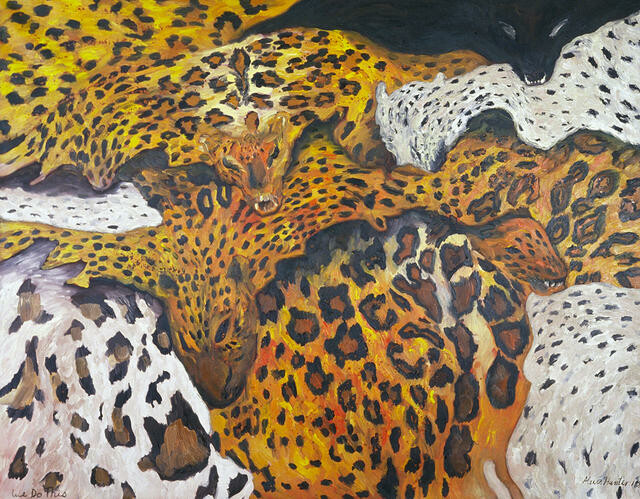B.
We do this by Alexis Hunter
Collection
This article first appeared as 'I am woman see me paint' in The Press on 14 March 2014.

Alexis Hunter We do this Collection Christchurch Art Gallery Te Puna o Waiwhetū; purchased 1992.
When asked in 1998 to imagine what her career would have been like had she been a man, Alexis Hunter said "I think I would have been more successful, but less interesting". A fearless engagement with the world from a feminist perspective was the hallmark of this internationally-recognised New Zealand-born artist, who died in Camden, London on 24 February. Colin McCahon, Hunter's painting tutor at the Elam School of Fine Arts, impressed upon her the artist's responsibility to be an active member of society and after emigrating to Britain in 1972 she became a member of the Women's Workshop, which promoted the use of collective strategies to further feminist concerns in art. She began to use photography, creating deliberately provocative photo-narratives that satirised and subverted the construct of femininity in Western culture. Images from her Approaches to Fear (1976-78) series were exhibited at the first female-curated Hayward Annual Exhibition in 1978. Another work from that year, The Marxist's Wife (still does the housework), featured a female hand scrubbing a poster of Karl Marx in a wry reflection on how socialist movements had side-lined women's concerns. Hunter's distinctive fusion of politics, provocation and humour saw her become a significant member of the Radical Feminism movement in Britain, and in 1982 she was selected to represent that country at the Sydney Biennale.
Hunter returned to painting in the late 1980s, critiquing the ideas of the 'goddess' and the 'artist's muse' in neo-expressionist oils that drew on the imagery of medieval art. Often combining sensuality with violence, her works retained their political conscience; the inspiration for We Do This (1988), from Christchurch Art Gallery's collection, was a newspaper photograph featuring hundreds of leopard and tiger skins that had been confiscated from poachers and piled up for burning. Hunter later recounted how when she exhibited in the United Arab Emirates she was summoned to a palace by the wife of a local sheik, who insisted she make a copy of this painting. Hunter demurred: "I said that the [then-Robert McDougall Art] Gallery would not allow me to make copies and explained that it was a 'Government Agency' in a low voice hinting at dark cellars and torture implements".
Hunter maintained an impressive international profile up until her death, with exhibitions at respected venues in Britain, Europe and the United States. She also kept up her links with New Zealand, returning regularly to exhibit and lecture. Recent revaluations of feminist art history have seen a resurgence of interest in Hunter's contribution and in 2007 her work was included in 'WACK! Art and the Feminist Revolution' at the Museum of Contemporary Art in Los Angeles, which later toured to New York and Vancouver. In the book accompanying that exhibition, Elizabeth Hamilton credited Alexis Hunter with 'creating a space for feminist art in a male-dominated world'.
Felicity Milburn
